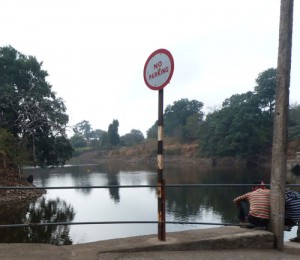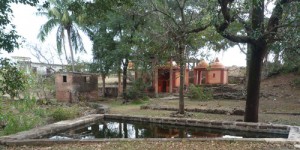Local legends and beliefs in parts of India often have their origins in the broader Indic tradition, writes PETER FRIEDLANDER.
What makes a landscape sacred? To explore this question, in 2014, I visited three sacred sites in the central Indian state of Madhya Pradesh—the town of Maheswar and two sites around the nearby ancient city of Mandu.
Maheshwar, a small town on the shores of the river Narmada, about 595 kilometres miles from the sea, is thought to have been continuously inhabited from as early as 1500 BCE. The city was entirely rebuilt by Rani Ahilyabai Holkar (1725–95), who shifted the capital of the Holkar dynasty from Indore to Maheshwar. In constructing her new capital, she overwrote the city’s earlier history and built a sacred landscape within it, linking some sites to other places in India where she had also funded building works.
Maps at her palace connected Maheshwar to 52 other sites around India where she had funded religious works—such as many of the riverside ghats in the sacred city of Varanasi, in Uttar Pradesh. She also funded the rebuilding of Varanasi’s famous Kashi Vishvanath temple, one of the holiest sites for Hindus.
In Maheshwar, the Rani is said to have had a vision of Kashi Vishvanath, a jyotirlinga, or devotional object, representing the god Shiva, at a site by the river, a short stroll from the palace, and then funded the construction of another Kashi Vishvanath temple (pictured ) at that site. Even today, every Monday her painting is put into a palanquin and accompanied by musicians and a priest as it tours the temples along the waterfront and makes a sacred circumambulation of the local microcosm she created of the macrocosm of India, by visiting the temples she built and making offerings at them.
North of Maheshwar, the Vindhya mountains form an escarpment on which lies a plateau, known as Mandu. Like Maheswar, this site has been inhabited since ancient times, but today is mostly associated with the Hoshang dynasty and the 15th-century ruler Hoshang Shah, who shifted his capital from Dhar to Mandu in 1401. Mandu is a major centre of the Adivasi tribal communities—considered the aboriginal population of India—in Madhya Pradesh, who form the majority of those living in Mandu today.

A major feature of the adivasi religious geography of Mandu is a pool of water, called the Reva Kund. Legend links its construction to the romance between a local shepherdess, Roopmati, and the last local ruler, Baz Bahadur, around 1500. According to legend, the king was out hunting when he was smitten by the sight of the local shepherdess. She agreed to marry him on condition that he lived with her in a pavilion looking to the Narmada River, and if Reva—another name for the Narmada—blessed the union by emerging as a spring at the site of Reva Kund.
The local Adivasi communities use Reva Kund as a site for religious rituals, in particular as a shamshan ghat—a burning ground. In Hinduism, the waters of the Narmada River have the power to grant liberation from the cycle of rebirth, if a person’s ashes are deposited in them. By equating the waters of Reva Kund to those of the Narmada River, the Adivasis believe the kund’s waters also have the power to grant liberation.
When I first visited Mandu in 1989 and talked to the Adivasis about their world views, they told me that, although they were Adivasi, they replicated the Brahmin, Rajput, Vaisya and Sudra castes—the four main Hindu castes—in their own caste divisions. Recalling those discussions now in this context, I am struck by the way that the process of mirroring—linking the local microcosm to the Indic macrocosm—is so pervasive in India.
The second site I visited at Mandu—Ravidas Kund—is outside the walls of the fort, on the main north road from Mandu to Dhar, on a ravine called Kakara Kho. The site of the Ravidas Kund today is a small pond, which is part of a stream flowing down the ravine. It is now a popular roadside stop, with drink and snack stalls, views down the ravine, and a recently built temple (pictured) constructed over the sacred pool. The main enclosure includes images of Ravidas—a 15th- century guru from a leather-working community from Varanasi—and the Hindu deities Vishnu and Shivalinga.
The guardian of the site, a local villager, said the main events at the temple occurred when visitors from the Ravidasi communities, who follow a monotheistic religion based on the teachings of Ravidas, visited from the nearby towns of Indore and Dhar to celebrate occasions such as Ravidas Jayanti—Ravidasis birthday.
Stories about Ravidas were first recorded in the Punjab and Rajasthan in the 17th century. The most famous tells of the time Ravidas was working outside his house, and donated an offering to a passing Brahmin to give on his behalf to the Ganges. The Brahmin later tossed the offering into the Ganges, which then manifested herself as the goddess Ganga, and gave in return a golden bracelet to the Brahmin.

Rather than giving the bracelet back to Ravidas, the Brahman gave it to the queen, who demanded a second one to make a matching pair. The Brahmin then had to admit to the king that the bracelet was not his to give, but was actually a gift from Ganga to Ravidas.
The king and his entourage visited Ravidas to persuade him to go to the Ganges to get a matching bracelet. But instead of going to the river, Ravidas summoned Ganga, who emerged from the pot Ravidas used for soaking leather and gave him a second matching bracelet. The first time stories related to the Ravidas Kund at Mandu were recorded was in the Vernacular Census of Marwar of 1891. In these stories Ravidas was from Mandu, not Varanasi, and lived at the site of the Ravidas Kund. The king becomes Raja Bhoj of Dhar, and the water vessel from which Ganga emerges becomes the Ravidas Kund.
In another story recorded in the census, Ravidas had two daughters of famed beauty. Raja Bhoj decided he would make them his wives, and arrived at Ravidas’ house, next to the Ravidas Kund, with a party of soldiers to carry the girls away. The girls then revealed themselves to be the rivers Ganga and Narmada, and transforming themselves into goddesses, leapt into the kund, from which a great flood emerged, sweeping away the king and his army.
The communities at the three sacred sites at Maheswar and Mandu employed narrative strategies that linked local microcosms to Indic macrocosms—and the mechanism for this linking is the power of darshan, or vision,which sanctifies a site.
Ahilyabai built a Kashi Vishvanath temple in Maheshwar, at the site where she had a vision of Shiva as he could be seen in Varanasi. The Adivasi community identify Reva Kund as sacred, because of the vision of the goddess Narmada at the Kund in Mandu. The community of followers of Ravidas sanctify the Ravidas Kund by making it the site of the vision of the Ganga and Narmada.
Main photo:
The Kashni Vishvanath temple at Mashewar.
